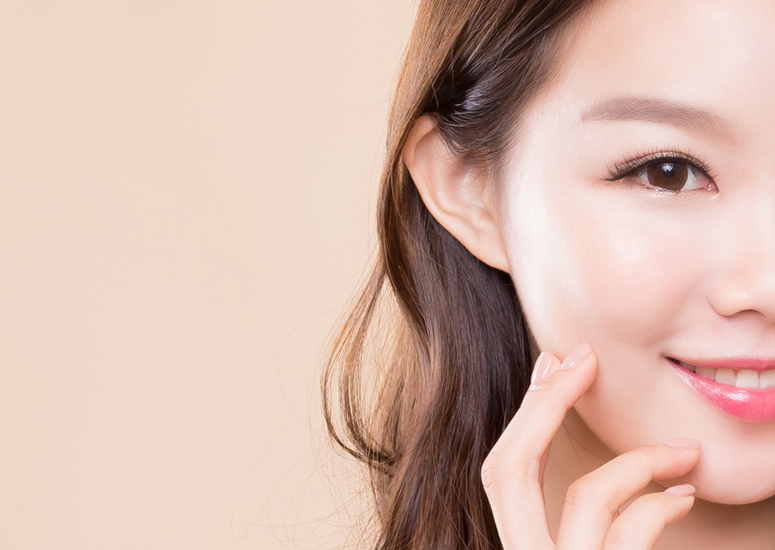
Asian Eye
What is Asian Eyelid Surgery?
Special consideration must be taken for the unique anatomy of the Asian eyelid and crease. The goal for Asian eyelid surgery is to form a natural shape, complementary to the Asian facial aesthetic. This may require moving or creating an upper eyelid crease that appears dynamic and natural.

How Is the Asian Eyelid Unique?
Asian eyelid anatomy takes into consideration the differences in skin thickness and texture, muscle attachment, and fat placement.
Skin
Thicker (particularly near the eyebrow), less prone to fine wrinkles, need to consider the higher risk of hyperpigmentation or thicker scars. This requires careful handling of the eyelid skin with fine sutures that minimize shearing of the skin. Strict sun protection is recommended to prevent hyperpigmentation.
Muscle
The muscle that allows eyelid opening, is attached to a thin sheet that pulls near the edge of the eyelid. The skin crease is formed through the pulling forces that attach the skin to the sheet. The typical natural crease in the Caucasian eyelid appears higher (7-12 mm) compared to the Asian eyelid (5-7 mm). Some Asian eyelids do not form creases if the attachment to the skin is lower.
Fat
There is a difference in the thin layer of fat directly under the muscle and placement of the orbital fat, which affects the placement or appearance of the eyelid crease.
Eyelid Crease Shape
The natural Asian eyelid fold tends to taper from the outer eye to the inner eye. In comparison, a caucasian eyelid crease has a more semilunar appearance with a greater height centrally. This must be considered in asian eyelid creases to prevent an unnaturally high or distorted shape.
Eyelid Corner Placement
The Asian eyelid outer corner is more commonly at the same level or elevated relative to the inner corner. Non-asian eyelids may be at the same level or lower.
Inner Eyelid Corner Skin
The inner eyelid skin (closest to the nose) has a wide variety of coverage of the caruncle, called the epicanthal fold. Surgical changes to the epicanthal fold must be carefully done as this may change the balance of the natural Asian appearance, and may cause obvious scarring.
Understanding Asian Eyelid Aesthetics
Dr. Lee has a deep understanding of Asian aesthetics. She further trained with South Korean Plastic Surgeons in the “beauty belt” of Gangnam in Seoul. There she studied techniques that have been well-established as well as new and modern approaches to eyelid surgery.
Asian Eyelid Surgery
The modern Asian eyelid surgery has evolved from simple crease formation, to refinement. Historical texts published refer to the procedure as “Westernizing” which is an outdated and culturally inaccurate philosophy. Simple crease formation to imitate Caucasian eyelid creases resulted in unnaturally round eye shapes, high static creases (thick line seen with closed eyes), thick “sausage” eyelid effect, and long-term ptosis.
Modern Asian eyelid surgery understands that the best results come from the harmony of the unique anatomy, with various cultural beauty ideals that are highly individualized. Creases are no longer excessively high and static, favouring a more dynamic appearance (ie: crease line disappears when you blink).
Preparing for Eyelid Surgery
The best outcome for surgery occurs when a patient has good general health, has reasonable expectations, does not smoke cigarettes, has regular healthy eye checks, and has a stable weight. Other special considerations include the use of contact lenses, eyedrops, makeup, artificial lashes, eyelid tape or glue, history of allergies and infections, and dryness.
Some physical features and measurements are needed to ensure this is the right procedure for you. Your surgeon will take measurements of your eyelids, cheekbones, and eye function as these natural features may affect your result.
You may need some tests before surgery to review your vision and tear film production. Blood thinners need to be stopped safely (including aspirin). We will provide a list of food to avoid for a minimum of 2 weeks before surgery.
Most upper eyelid surgeries are short and performed awake; some under mild sedation. If you will be sedated using general anesthesia, you will see the anesthesiologist beforehand.
What to Expect From Surgery
Eyelid surgery is “day surgery” meaning you will go home the same day. Depending on the surgical plan, this may range between 30 minutes to 2 hours.
On the day of surgery the surgeon will mark the eyelid. The scars are designed to be within natural creases or shadows. Eye drops and local freezing may be placed for pain control. During the surgery, the eye may be protected by placing a temporary shield. If awake for the surgery, your surgeon may ask you to occasionally sit up and open the eyelid to check for symmetry. Small sutures are placed in the skin and a healing ointment is applied over top.
Recovery After Surgery
The usual recovery time is 2 weeks after surgery. During this time, you will have swelling and bruising. Since the eyelid skin is very thin, this is easily seen. The swelling peaks in the first 3 days after surgery. This is the time you will use regular cold compresses and keep your head elevated. You should not exercise during this time.
The skin heals quickly and sutures will be removed in 10 days. After 2 weeks, most of the swelling disappears. Light makeup that does not require heavy rubbing may be used.
There is a small amount of lingering eyelid swelling that can last for 3-4 months. The internal scarring softens and changes over a 1 year period when the result is stable.

Book a Consultation
Schedule your personal consultation with Dr. Lee to talk about Asian Eye surgery.
Discover the Possibilities by Viewing Our Before and After Gallery

